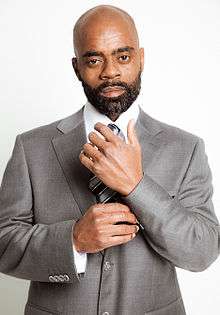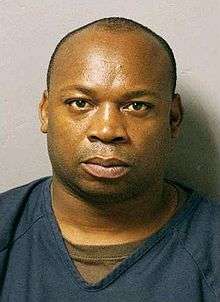Drug lord
A drug lord, drug baron, kingpin or narcotrafficker is a high ranking crime boss who controls a sizable network of people involved in the illegal drug trade. Such figures are often difficult to bring to justice, as they are normally not directly in possession of something illegal, but are insulated from the actual trade in drugs by several layers of staff. The prosecution of drug lords is therefore usually the result of carefully planned infiltration into their networks, often using informants from within the organization.
Organisational Role
Since the 1970s, research on organised crime leadership (and by extension, drug lords) has evolved, where once studies emphasised the importance of the leader's human capital (e.g. individual traits), it has now developed to focus upon the leader's social capital (e.g. information and resource brokers, social status, access to information).[1]
List of well-known drug lords
Miguel Ángel Félix Gallardo
Known as "El Padrino"(The Godfather) and "El Jefe de Jefes"(The boss of bosses), he is the founder and former leader of the Guadalajara Cartel, the first mexican cartel ever established. He had strong ties with the Cali Cartel and Escobar's Medellin Cartel as he distributed drugs for them. He controlled almost all of the drug trafficking in Mexico and the corridors along the Mexico–United States border in 1970s and the 80s. Until the end of the 1980s, Guadalajara Cartel headed by Félix Gallardo was one of the most powerful cartels in the world. He had huge involvement in politics and bribed political authorities to protect himself and his business. After his capture in 1989 for the alleged murder of DEA agent Enrique Camarena, Félix decided to divide up the trade he controlled as it would be more efficient and less likely to be brought down by law enforcement. Félix Gallardo instructed his lawyer to convene the nation's top drug narcos in 1989 at a house in the resort of Acapulco where he designated the plazas(turfs) or territories. The Tijuana route would go to his nephews, the Arellano Felix brothers. The Cuidad Juárez route would go to the Carrillo Fuentes family. Miguel Caro Quintero would run the Sonora corridor. Joaquín Guzmán Loera and Héctor Luis Palma Salazar were left the Pacific coast operations, with Ismael Zambada García joining them soon after and thus becoming the Sinaloa Cartel, who was not yet a party to the 1989 pact. Félix Gallardo still planned to oversee national operations and remained one of Mexico's major traffickers, maintaining his organization via mobile phone until he was transferred in the 1990s to the Altiplano maximum security prison and lost all remaining contacts with other drug lords. On 18 December 2014, federal authorities approved his request to transfer to a medium-security prison in Guadalajara (State of Jalisco), due to his declining health. He still strongly denies any involvement in the murder of Enrique Camarena. He was particularly known for using less violence.
Joaquín "El Chapo" Guzmán
According to the U.S. Drug Enforcement Administration (DEA).[2] In the 1980's he was a member of the Guadalajara Cartel and used to work for Miguel Ángel Félix Gallardo. After Félix's arrest in 1989, Guzmán formed the Sinaloa Cartel along with Ismael Zambada García and Héctor Luis Palma Salazar. He is well known for his use of sophisticated tunnels—similar to the one located in Douglas, Arizona—to smuggle cocaine from Mexico into the United States in the early 1990s. In 1993, a 7.3-ton shipment of his cocaine, concealed in cans of chili peppers and destined for the United States, was seized in Tecate, Baja California. That same year he barely escaped an ambush by the Tijuana Cartel led by Ramon Arellano Felix and his gunmen. After being captured in Guatemala, he was jailed in 1993 and in 1995 he was moved to the maximum-security prison called Puente Grande, but paid his way out of prison and hid in a laundry van as it drove through the gates. On 22 February 2014, Guzmán was arrested again. He is considered a folk hero in the narcotics world, celebrated by musicians who write and perform a narcocorridos (drug ballads) extolling his exploits.[3] For example, Los Traviezos recorded a ballad extolling his life on the run.[4] In July 2015, Guzman escaped a second time from a maximum-security prison through a hole in a shower floor that led to a mile-long tunnel, ending at a nearby house.[5] A large-scale manhunt ensued. On 8 January 2016, Guzmán was captured by the Mexican Marines.[6]
William Jardine
William Jardine (24 February 1784 – 27 February 1843) was a Scottish physician turned drug lord.[7] He also co-founded the Hong Kong-based conglomerate Jardine, Matheson & Co. In 1803, he became a surgeon's mate aboard the Brunswick belonging to the East India Company, and set sail for India. In May 1817, he abandoned medicine and went into drug trafficking. Jardine was a resident in China from 1820 to 1839. His early success in Canton as a commercial agent for opium merchants in India led to his admission in 1825 as a partner in Magniac & Co. In 1839, after Imperial Commissioner Lin Zexu destroyed 20,000 cases of opium that had been smuggled into China, Jardine arrived in London that September to press Foreign Secretary Lord Palmerston for a forceful response.[8]
Jorge Alberto Rodriguez
Jorge Alberto Rodriguez, also known as Don Cholito, is a notorious Puerto Rican and Colombian mixed drug lord from New York, who headed the 400 criminal organization, a dismantled secret cell of the Cali Cartel. Pulled into the drug trade at age 12, he left home at age 14 to begin working for his Father, Gilberto Rodríguez Orejuela, who headed the Cali Cartel. Within six years he had made hundreds of millions by shipping drugs from Colombia to nearly every U.S. state. He was one of the most ruthless international drug lords unknown to law enforcement or governments. During that time, the nation's murder rate and cocaine-related hospital emergencies doubled. He was arrested in 1990 in Tallahassee, Florida and sentenced to a 25-year prison term for a number of federal violations. Following his conviction, Rodriguez continued to operate his illicit business from behind bars, importing as much as 12,500 kilograms (27,600 lb) into the U.S. every month and ordering numerous murders of informants, witnesses, and law-enforcement officials in the U.S. and Colombia. He reigned and flourished while incarcerated until he was placed in court-ordered high-security isolation in 1994.[9][10][11]
Pablo Escobar
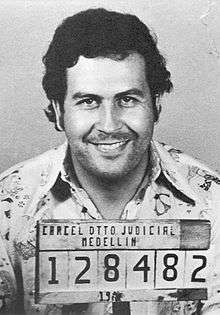
Pablo Emilio Escobar Gaviria (December 1, 1949 – December 2, 1993) was a Colombian drug overlord. Often referred to as the "World's Greatest Outlaw", Escobar was perhaps the most elusive cocaine trafficker to have ever existed.[12] In 1989 Forbes magazine declared Escobar as the seventh-richest man in the world, with an estimated personal fortune of US$25 billion.[13] In 1986, he attempted to enter Colombian politics. It is said that Pablo Escobar once burnt two million dollars in cash to keep his daughter warm while on the run.[14]
Griselda Blanco
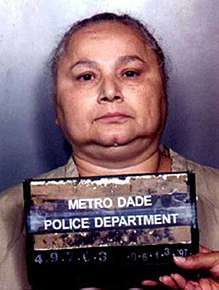
Griselda Blanco (1943–2012), known as the "Godmother of Cocaine", was a drug lord who operated between Miami and Colombia during the 1970s and 1980s. During the height of her operation, she smuggled nearly 1,600 kilograms (3,500 lb) of cocaine into the U.S. every month through a network in south Florida.[15] She was noted for her ruthlessness and use of extreme violence, employing tactics such as publicly assassinating people in broad daylight, bayoneting a rival trafficker inside Miami International Airport, and inventing the drive-by motorcycle shooting execution method.[16][17] It was estimated that she was responsible for the homicides of 200 people in Colombia, Florida, New York, and California.[16] Arrested in 1985 for drug-trafficking charges, she was subsequently convicted and spent almost 20 years in a U.S. prison.[18] She was killed by motorcycle hitmen in Colombia on 3 September 2012 as she was coming out of a butcher's shop.[19]
Roberto Suárez Gómez
Pablo Escobar started to buy cocaine from Roberto Suárez in the 1970s when he had just created the Medellín cartel. Suárez started building cocaine laboratories in the middle of the Bolivian Amazon jungle and in the zone of "Los Yungas" in the end of the 1960s and created the first cocaine cartel in Bolivia called "La Corporación". At first, the Medellin cartel bought cocaine at $8,000 per kilogram ($3,600/lb). La Corporación then sold cocaine-based paste to Colombian cartels, and they finished and distributed it in the east of the United States. The finished cocaine was sold directly to Mexican cartels for distribution in the west of the United States. Suárez received untold amounts of money, but as detectives and journalists discovered the corruption between Bolivia and the U.S., the empire Suárez built began to fall. Suárez was arrested by the DEA in 1988, and Escobar took over of the production and distribution of 80% of the world's cocaine.
Rick Ross
Rick Ross (born January 28, 1960),[20] a.k.a. "Freeway" Ricky Ross, is a convicted drug-trafficker best known for the drug empire he presided over in Los Angeles in the early 1980s.[21] The nickname "Freeway" came from Ross growing up next to the 110 Harbor Freeway.[22] During the height of his drug dealing, Ross was said to have made "$2 million in one day." According to the Oakland Tribune, "In the course of his rise, prosecutors estimate that Ross transported several tons of cocaine to New York, Ohio, Pennsylvania, and elsewhere, and made more than $600 million in the process."[23]
In 1998, Ross was sentenced to life imprisonment after being convicted of purchasing more than 100 kilograms of cocaine from a federal agent during a sting operation. Ross became the subject of controversy later that year when a series of articles by journalist Gary Webb in the San Jose Mercury News revealed a connection between Ross's main cocaine source, Danilo Blandon, and the CIA as part of the Iran–Contra affair.[24] Ross's case went before the federal court of appeals and his sentence was reduced to 20 years. He was later moved to a halfway house in March 2009 and released from custody on September 29, 2009.[20]
In June 2014, Ross released his book, Freeway Rick Ross: The Untold Autobiography, co-written by crime-writer Cathy Scott.[25]
Manuel Noriega
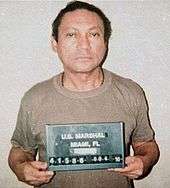
For more than a decade, Panamanian Manuel Noriega was a highly paid CIA asset and collaborator, despite knowledge by U.S. drug authorities as early as 1971 that the general was heavily involved in drug trafficking and money laundering. Noriega facilitated "guns-for-drugs" flights for the Nicaraguan Contras, whom the U.S. were heavily supporting: providing protection and pilots, safe havens for drug cartel officials, and discreet banking facilities.[26] He was arrested in 1990.
Amado Carrillo Fuentes
As a top drug-trafficker in Mexico, Amado Carrillo (1956–1997) was transporting four times more cocaine to the U.S. than any other trafficker, building a fortune of over $25 billion. He was called El Señor de Los Cielos ("The Lord of the Skies") for his use of over 22 private 727 jet airliners to transport Colombian cocaine to municipal airports and dirt airstrips around Mexico, including Juárez. He was a member of the Guadalajara Cartel and worked for Miguel Ángel Félix Gallardo. After Félix was arrested, Amado formed the Juarez Cartel. In the months before his death, the DEA described Carrillo as the most-powerful drug trafficker of his era, and many analysts claimed profits neared $25 billion, making him one of the world's wealthiest men.
Ramon Arellano Felix
Arellano Felix was a Mexican drug trafficker linked to the Tijuana drug cartel (a.k.a. the Arellano-Félix Organization).[27] Arellano Félix was allegedly one of the most ruthless members of the cartel and was a suspect in various murders. He had been linked by Mexican police to the 1997 massacre of twelve members of a family outside of Ensenada, Baja California. The family was related to a drug dealer that had an unpaid debt to the Arellano Félix Cartel. On September 18, 1997, Arellano Félix was placed on the FBI's ten most-wanted list.[28] In a sealed indictment in the United States District Court for the Southern District of California, he was charged with conspiracy to import cocaine and marijuana.. He and his brothers were the heads of the Tijuana Cartel and worked for their uncle Miguel Ángel Félix Gallardo until 1989 when Félix was imprisioned. They inherited the Tijuana territory from Félix soon after his arrest
Ismael Zambada García
Ismael Zambada García is a drug smuggler in Mexico.[29] Mexico's top anti-drug prosecutor, José Santiago Vasconcelos, called Zambada "drug dealer No. 1" and said the fugitive has become more powerful as his fellow kingpins have fallen, including one who was allegedly killed on Zambada's orders.
Klaas Bruinsma
Klaas Bruinsma (1953–1991) was a major Dutch drug lord, shot to death by mafia member and former police officer Martin Hoogland. Bruinsma was known as "De Lange" ("the tall one") and as "De Dominee" ("the preacher") because of his black clothing and his habit of lecturing others.
Arturo Beltran Leyva
Marcos Arturo Beltrán Leyva (September 27, 1961 – December 16, 2009) was the leader of the Mexican drug-trafficking organization known as the Beltrán-Leyva Cartel, which is headed by the Beltrán Leyva brothers: Marcos Arturo, Carlos, Alfredo and Héctor.[30][31] The cartel was engaged in cocaine, marijuana, heroin, and methamphetamine production, transportation, and wholesaling. It controlled numerous drug-trafficking corridors into the United States. and was also responsible for human smuggling, money laundering, extortion, kidnapping, murder, contract killing, torture, gun-running, and other acts of violence in Mexico.[32] The organization was connected with the assassinations of numerous Mexican law-enforcement officials.[32]
Frank Lucas
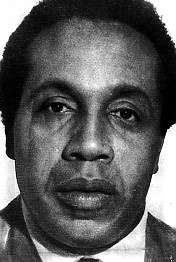
Frank Lucas is a former heroin dealer and organized crime boss who operated in Harlem, New York during the late 1960s and early 1970s. He was known for cutting out middlemen in the drug trade and buying heroin directly from his source in the Golden Triangle. Lucas boasted that he smuggled heroin using the coffins of dead American servicemen,[33][34] but this claim is denied by his South Asian associate, Leslie "Ike" Atkinson.[35] His career was dramatized in the 2007 feature film American Gangster starring Denzel Washington.
Leroy Barnes
Leroy Antonio "Nicky" Barnes (born October 15, 1933) is a former drug lord and crime boss of the notorious African-American crime organization known as The Council, which controlled the heroin trade in Harlem, New York during the 1970s.[36] In 2007 he released a book, Mr Untouchable, written with Tom Folsom, and a documentary DVD of the same name, about his life.[37][38] In the 2007 film American Gangster, Barnes is portrayed by Cuba Gooding, Jr.
Zhenli Ye Gon

Zhenli Ye Gon (traditional Chinese: 葉真理;[39] born January 31, 1963, Shanghai, People's Republic of China) is a Mexican businessman of Chinese origin accused of trafficking pseudoephedrine into Mexico from Asia. At the time of his arrest, he had $207 million cash and 18 million Mexican pesos in his house. He claimed that he was forced by Javier Lozano Alarcón, putatively identified as the Secretary of Labor, to keep it at his home and that this money would be used during Felipe Calderón's presidential campaign in 2006. He is the legal representative of Unimed Pharm Chem México. The charges against him were dismissed with prejudice in August 2009[40] as a result of the efforts of his attorneys, Manuel J. Retureta [41] and A. Eduardo Balarezo.[42]
Christopher Coke
Michael Christopher Coke (born 13 March 1969),[43] a.k.a. Dudus,[44] is a Jamaican drug lord and the leader of the Shower Posse gang. He is the youngest son of drug lord Lester Lloyd Coke whose extradition had also, prior to his 1992 death in a Jamaican prison cell, been requested by the U.S.[44] Until the younger Coke's handover to U.S. forces on 24 June 2010, "Dudus" served as the de facto leader of Tivoli Gardens in the city of Kingston;[44] prior to his 2010 capture Jamaican police were unable to enter this neighborhood without community consent.[44]
The son of a prominent drug lord, Coke grew up wealthy, going to school with children of the country's political elite. Ruling the gang where his father left off, he became a leader in the community of Tivoli Gardens, distributing money to the area's poor, creating employment, and setting up community centers.[45]
In 2009, the U.S. began requesting his extradition, and in May 2010, a recalcitrant Government of Jamaica issued a warrant.[44] That same month the government took steps to capture Coke. In a run-up to Coke's arrest, more than 70 people–all but one of them civilians–died in a 24 May 2010 raid of Tivoli Gardens.[44] He was arrested at a Jamaican checkpoint on 22 June 2010.[44]
Demetrius Flenory
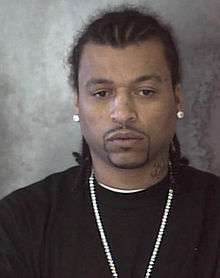
Demetrius Flenory is known as one of the co-founders of the Black Mafia Family, a Detroit-based drug-trafficking organization involving the large-scale distribution of cocaine throughout the U.S. from 1990 to 2005.[46] There are currently plans to produce a film based upon his career.[47][48]
José Figueroa Agosto
Jose Figueroa Agosto (born June 28, 1964), also known as "José David Figueroa Agosto", "Junior Capsula" and "the Don Pablo Escobar of the Caribbean", is a Puerto Rican drug trafficker.[49] As the head of a major drug trafficking organization that made 90% of cocaine in Puerto Rico, Figueroa Agosto is considered to be one of the most dangerous drug lords of Puerto Rico.[50] He was the most wanted fugitive in Puerto Rico and the Dominican Republic.[51]
Jari Aarnio
Jari Seppo Aarnio (born 5 September 1957) is the former chief investigator and head of Helsinki's anti-drugs police, who spent 30 years in the anti-drugs force in Finland.[52] He has been sentenced to jail for drug crimes and other offences.[52][53]
Modern drug lords
Following the death of Pablo Escobar in 1993, significant changes occurred in the structure or drug trade, departing from massive cartels such as Juan David Ochoa's Medellín cartel. Drug lords have begun breaking the large cartels into much smaller organizations. In so doing, they decreased the number of people involved and shrank their role as targets—most likely in an attempt to avoid the fate of their predecessors. With newer technology, drug lords are able to manage their operations more effectively from behind the scenes, keeping themselves out of the spotlight and off the FBI and DEA wanted lists. These smaller cartels are slowly proving to be safer and more profitable for those involved.[54]
Up until the demise of Pablo Escobar, in many instances, drug lords essentially ran the governments of the locations they controlled through bribery, and assassination. However, this way of controlling their operations is becoming less prevalent. One of the most-notorious examples of the treatment given to drug lords is in the incarceration of Escobar. Although Escobar was, after turning himself in, jailed for his participation in drug trafficking in Colombia, the "jail" in which he was captive was a million-dollar palace built with his own funds. Another famous crime lord who enjoyed lightened jail life was Al Capone, who continued to run his business from his jail cell, which contained tables, chairs, a bed, flowers, and paintings. For drug lords of the past, jail often served as a way to avoid further persecution.
In Mexico, after the arrest of Miguel Ángel Félix Gallardo, there was a rise in the rate of violence. Félix was particularly known for his use of non-violence to keep his business running smooth and had bribed many political authorities for protecting himself and his business. He divided his territory and the remaining members of his organization formed other cartels. He kept in contact with the drug lords and remained as one of Mexico's major traffickers until he was transferred to Altiplano maximum security prison. Eventually the cartels fought each other for territory and lead to brutal Drug Wars which caused thousands of deaths.
In recent times, drug lords seldom control local and regional governments, having less influence over their surroundings and their ability to continue to run their businesses from jail.[33][55]
Another trend that has been emerging in the last decade is a willingness of local authorities to cooperate with foreign nations, most notably the U.S., in an effort to apprehend and incarcerate drug lords. Recently, especially in the last five years, countries have been more willing to extradite their drug lords to face charges in other countries, an act that not only benefits them directly but also gives them favor with foreign governments. Mexico extradited 63 drug dealers to the U.S. in 2006. However, extradition may be prohibited if the person faces the death penalty.[34][34]
See also
- Drug barons of Colombia
- Drug cartel
- List of Mexico's 37 most-wanted drug lords
- War on Drugs
References
- Calderoni, Francesco (31 March 2020). "The nature of organised crime leadership: criminal leaders in meeting and wiretap networks". Crime, Law and Social Change. 72: 419–444 – via SpringerNature CAUL.
- "Joaquin Guzman Has Become The Biggest Drug Lord Ever". Forbes. Retrieved 2013-12-12.
- "'He Leads a Gang of Mafioso Gunmen': Songs in Honor of Mexico's 'El Chapo'". The Wall Street Journal. June 13, 2009. Retrieved 2010-12-01.
- Grayson, George (August 31, 2009). Mexico: narco-violence and a failed state?. Transaction Publishers. pp. 62–63. ISBN 978-1-4128-1151-4. Retrieved 2010-12-01.
- "Mexican Drug Lord Joaquin Guzman Loera Escapes Prison 2015 : People.com". PEOPLE.com.
- Patrick Radden Keefe (July 12, 2015). "El Chapo Escapes Again". The New Yorker.
- William Jardine: Architect of the First Opium War, Benjamin Cassan
- Grace, Richard J.. "Jardine, William (1784–1843)". Oxford Dictionary of National Biography (2004 ed.). Oxford University Press. doi:10.1093/ref:odnb/37595. Accessed 29 April 2010
- U.S. vs Jorge Alberto Rodriguez, 981 Federal Reporter 2d, Page 1199
- "Federal Register, Volume 74 Issue 77 (Thursday, April 23, 2009)". gpo.gov.
- U.S. Bureau Of Prisons Prisoner Registry Number: 09086-017
- "Pablo Escobar Gaviria - English Biography - Articles and Notes". ColombiaLink.com. Archived from the original on September 28, 2011. Retrieved 2011-11-12.
- Zschoche, Sören (April 18, 2008). "The 5 richest criminals of all time". World Financial Blog. Retrieved May 9, 2011.
- "Pablo Escobar burnt £5m in cash to keep warm on the run". The Daily Telegraph. London. November 3, 2009.
- Corben, Billy (director); Cosby, Charles (himself); Blanco, Griselda (herself) (July 29, 2008). Cocaine Cowboys 2: Hustlin' with the Godmother (DVD). Magnolia Home Entertainment. ASIN B00180R03Q. UPC 876964001366. Retrieved October 3, 2010.
- Corben, Billy (2 September 2012). "Griselda Blanco: So Long and Thanks for All the Cocaine". Vice. Retrieved 24 July 2017.
- Greene, David (6 September 2012). "'Godmother' Of Cocaine Trade Murdered In Colombia". NPR Morning Edition. Retrieved 24 July 2017.
- Villarreal, Ryan (4 September 2012). "Colombian Drug Lord Griselda Blanco's Life of Violence Comes Full Circle". International Business Times.
- "Godmother of Cocaine,' Colombian drug lord who ran Miami cocaine empire in 70's and 80's, shot to death by motorcycle gunmen". Daily News. New York. Retrieved 7 June 2013.
- "Inmate Locator - Ricky Ross". bop.gov. Federal Bureau of Prisons. Retrieved 2011-11-12.
- "CIA Contra Crack Cocaine Controversy - D. Law Enforcement Investigations of Ross". USDOJ.gov. United States Department of Justice Archive. Retrieved 2011-11-12.
- Sager, Mike (September 25, 2013). "Say Hello to Rick Ross". Esquire magazine.
- Scott JohnsonOakland Tribune (2012-04-17). "Oakland Tribune". Insidebayarea.com. Retrieved 2013-12-12.
- "NBC: Drugs and the CIA". YouTube. May 29, 2007.
- "Rick Ross Book signing Event Recap - Los Angeles Sentinel". Los Angeles Sentinel.
- Lormand, Eric (May 8, 2007). "Panama: The Resume of Manuel Noriega". personal.umich.edu
- Steller, Tim (April 15, 1998). "Mexican drug runners may have used C-130 from Arizona". The Arizona Daily Star. Archived at California State University Northridge. Archived from the original on 2008-01-03. Retrieved 2007-09-26.
- "The Business - Arellano-Felix Cartel". Drug Wars - Frontline. PBS. Retrieved 24 July 2017.
- "Portrait Of A Mexican Drug Lord". CBS News. October 24, 2003.
- Garza, Antonio O. (May 30, 2008). "President Bush Designates Beltran Leyva and his Organization Under Kingpin Act". Embassy of the U.S. in Mexico. Archived from the original on August 27, 2009. Retrieved 2009-08-03.
- Starr, Penny (April 14, 2009). "DEA Names Eleven 'Most Wanted' Mexican Fugitives Sought by U.S." CNS News. Archived from the original on 2009-06-15. Retrieved 2009-08-15.
- "Narcotics Rewards Program: Marcos Arturo Beltran-Leyva". U.S. Department of State. 2008. Archived from the original on 2010-02-28. Retrieved 2009-12-20.
- Vincent, Isabel (January 29, 2006). "Where the drug lords are Kings". 120 (3). Maclean's. Academic Search Premier. pp. 23–24, 2p, 3c. Archived from the original on May 31, 2012. Retrieved 2011-11-12.
- "Mexico extradites 'unprecedented' number of drug lords to U.S.". USA Today. January 20, 2007. Retrieved November 12, 2011.
- McKinley Jr., James C. (February 9, 2005). "Drug Lord, Ruthless and Elusive, Reaches High in Mexico". New York Times. 154 (53120). Academic Search Premier. p. A3, 1/3p, 1 map, 2bw. Retrieved 2007-04-18.
- Sam Roberts (March 4, 2007). "Crime's 'Mr. Untouchable' Emerges From Shadows". The New York Times. Retrieved 2010-05-02.
- Leroy "Nicky" Barnes, Tom Folsom. Mr. Untouchable: My Crimes and Punishments (March 6, 2007 ed.). Rugged Land. p. 352. ISBN 1-59071-041-X.
- Mr. Untouchable (2007) on IMDb
- "Profile: Gilberto Rodriguez Orejuela". BBC. December 4, 2004. Retrieved November 12, 2011.
- Jeffery, Jeff (August 28, 2009). "Federal Judge Dismisses Ye Gon Case With Prejudice". Legal Times. Retrieved May 12, 2011.
- "Returetawassem.com" Manuel J. Retreat.
- "Balarezo.net". A. Eduardo Balarezo.
- "Who is 'Dudus'? - Lead Stories - Jamaica Gleaner - Monday | May 24, 2010". Jamaica Gleaner. 2010-05-24. Retrieved 2013-12-12.
- Schwartz, Mattathias (2011-12-12), "A Massacre in Jamaica", The New Yorker, pp. 62–71, retrieved 2011-12-26
- Extraditing Coke. Al Jazeera. June 30, 2010.
- "Black Mafia Family Members Sentenced to 30 Years" Archived September 16, 2011, at the Wayback Machine. September 12, 2008. Drug Enforcement Administration. Press release.
- "Film in works about Detroit gangster Demetrius Flenory, Black Mafia Family" . June 25, 2011. Examiner.com
- Clark, Kevin L. (June 24, 2011). "The 'Black Mafia Family' Movie Is Coming To A Theater Near You!". complex.com, Complex Media.
- "Caribbean 'drug baron' arrested". July 18, 2010 – via www.bbc.co.uk.
- Fieser, Ezra (August 18, 2010). "The Caribbean Drug Kingpin Turned Porn Star" – via content.time.com.
- "DEA agents nab alleged drug kingpin in Puerto Rico - CNN.com". www.cnn.com.
- "Finland jails police chief Aarnio for drug-smuggling". BBC. 29 December 2016. Retrieved 17 March 2018.
- "Convicted ex-Helsinki drug cop Jari Aarnio begins appeal to overturn 10-year prison sentence". Yle. 14 September 2017. Retrieved 17 March 2018.
- "Special: Drug organization profiles - The Drug Lords". CNN. Archived from the original on October 29, 2007. Retrieved October 29, 2007.
- Kershaw, Sarah (February 20, 2006). "Dizzying Rise and Abrupt Fall For a Reservation Drug Lord". New York Times. 155 (53496). Academic Search Premier. p. A1-A10, 2p, 2c. Retrieved 2011-11-12.
External links
- 31 Notorious Drug Lords – slideshow by Life magazine
